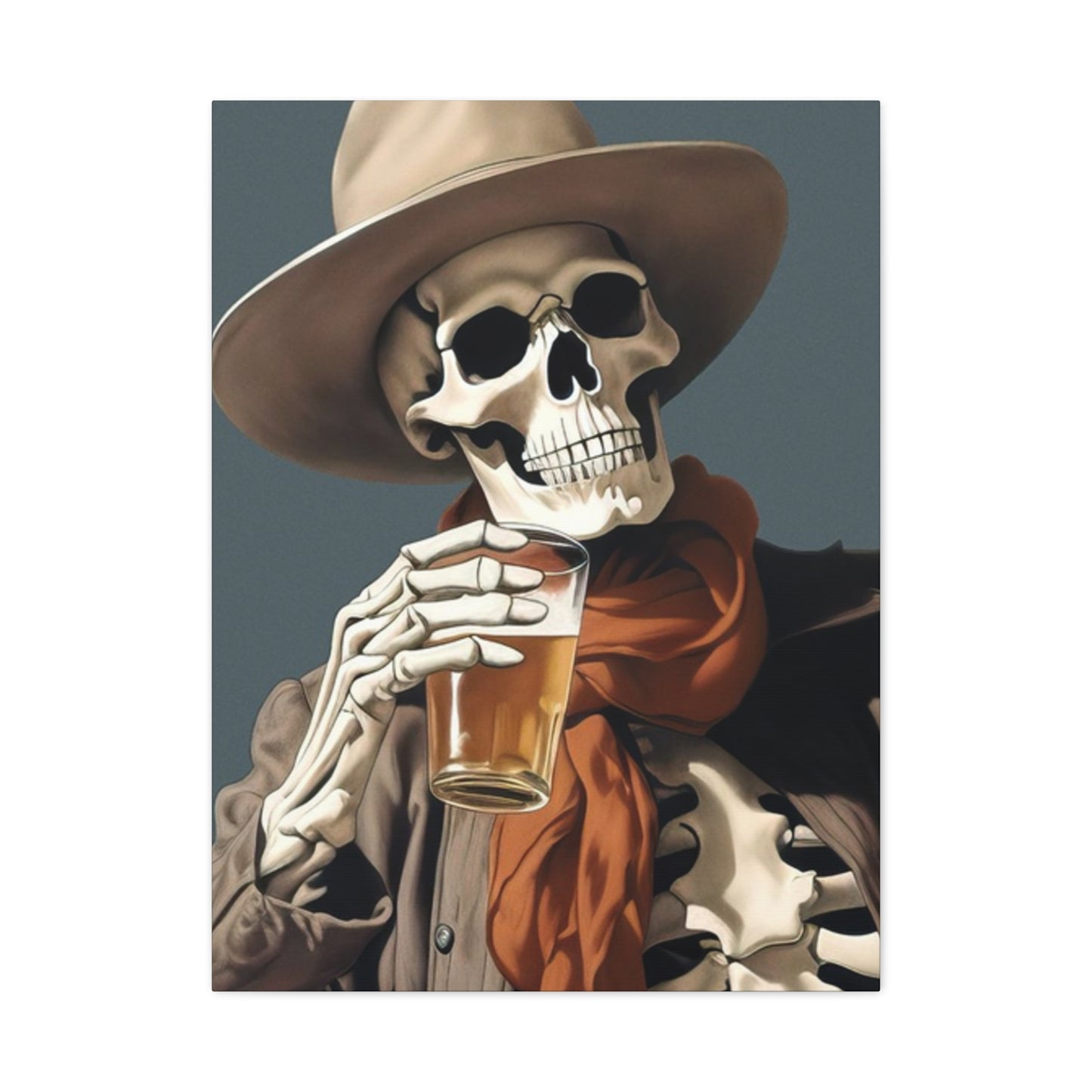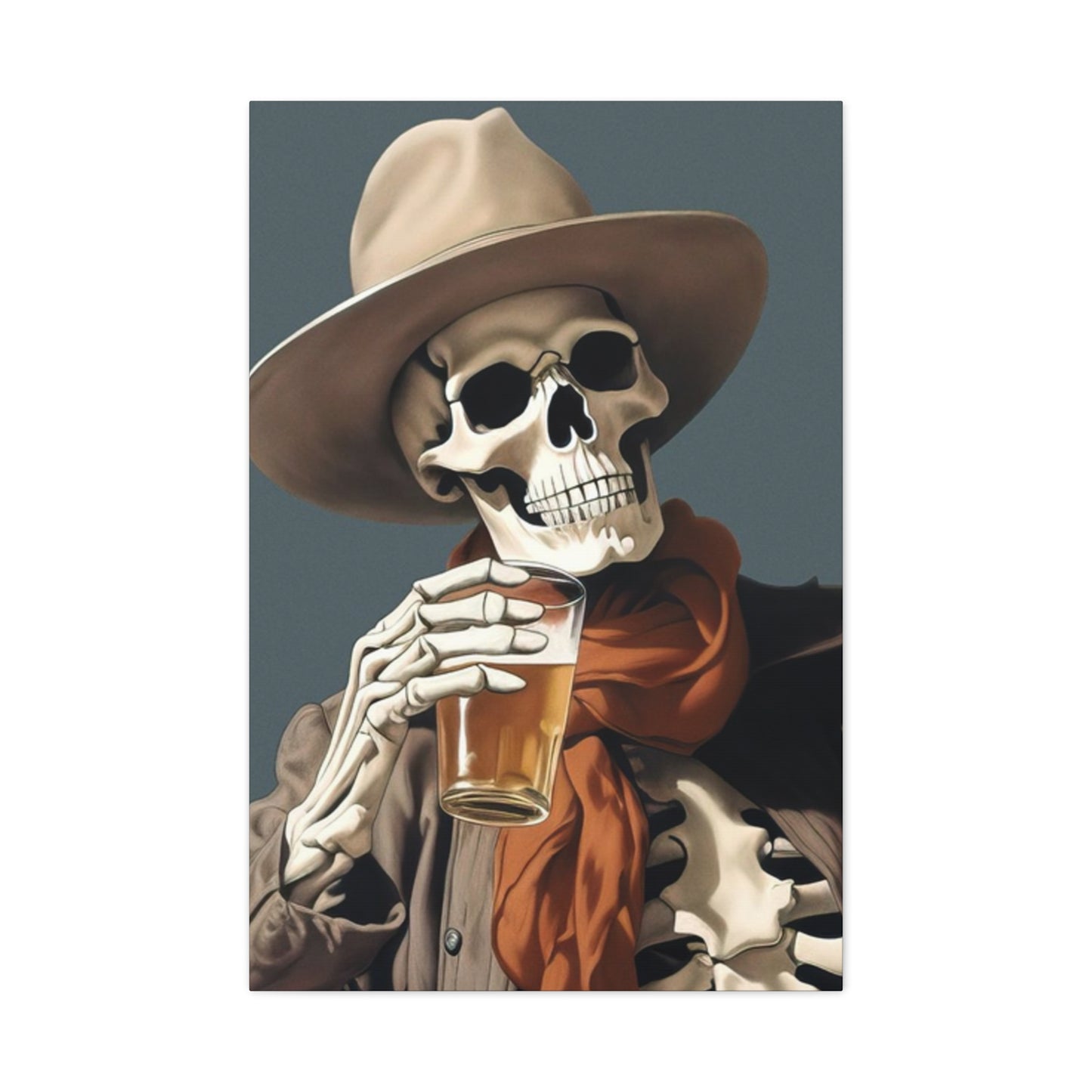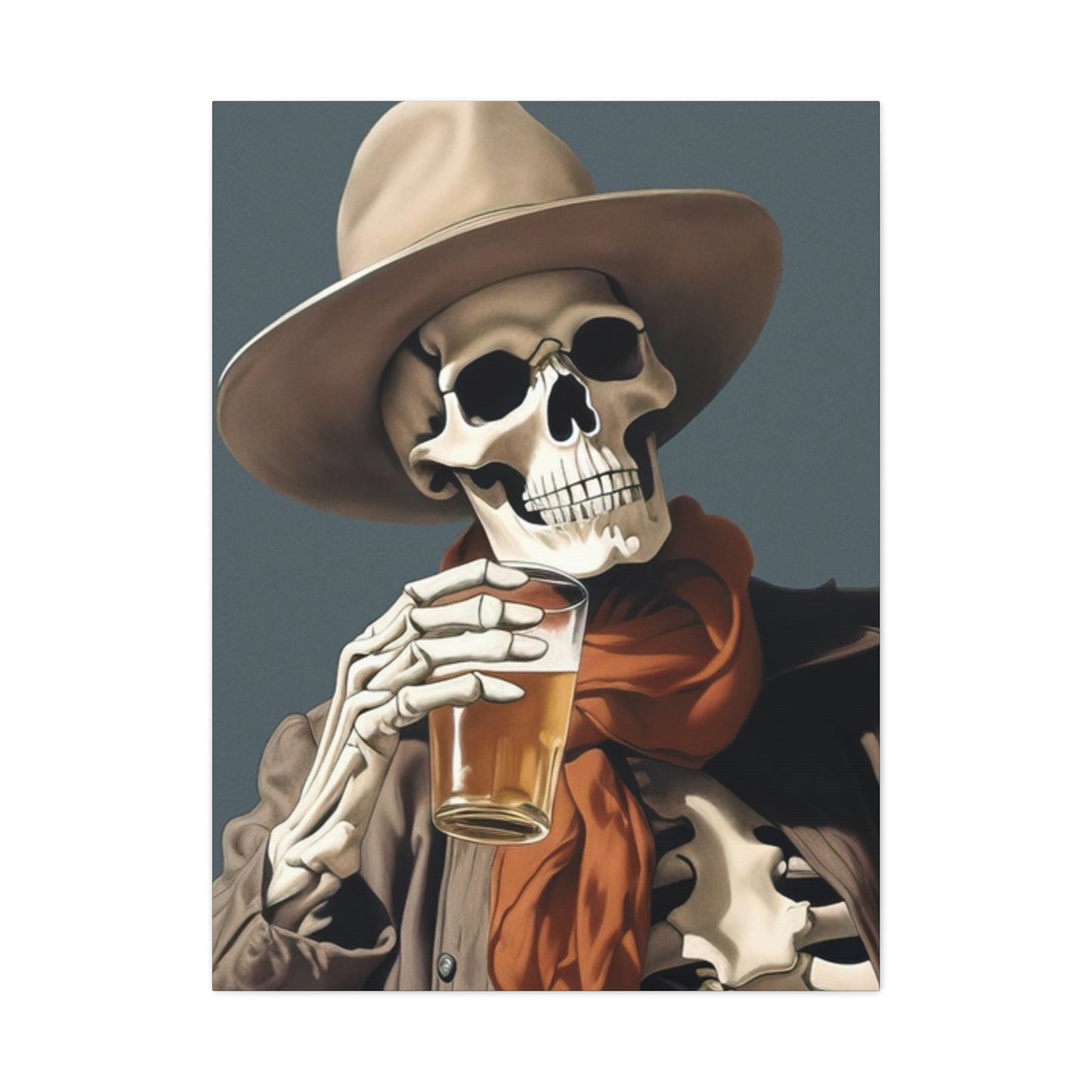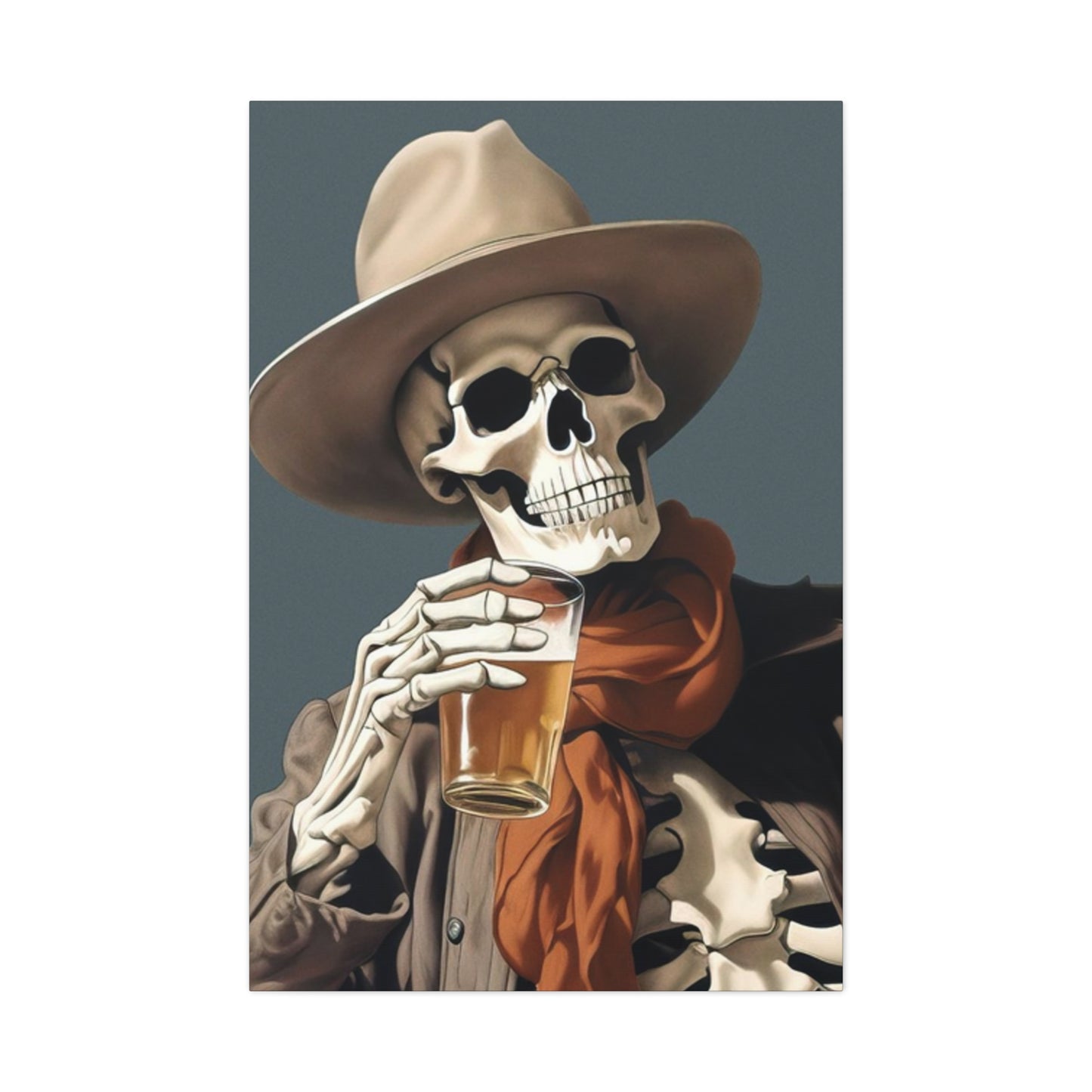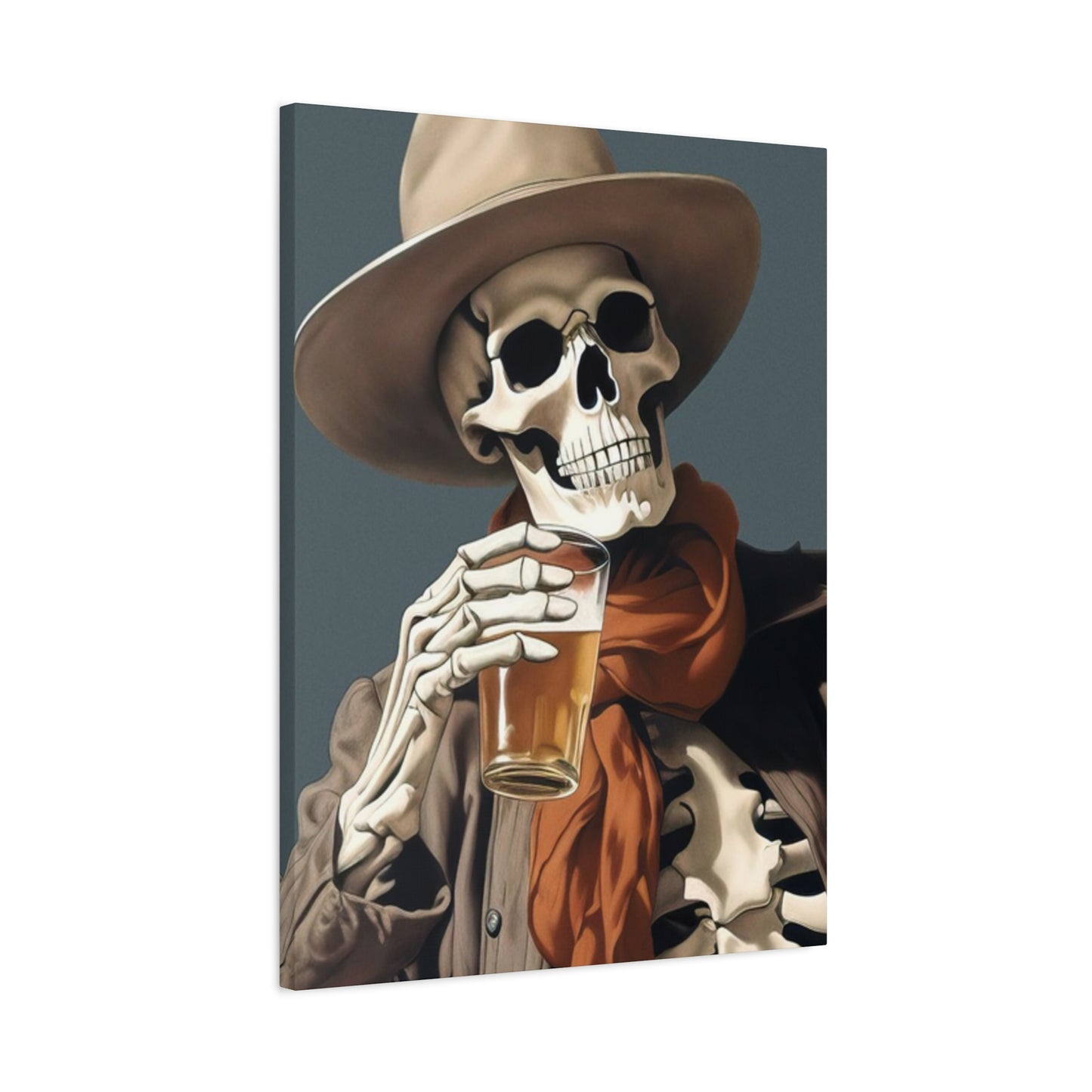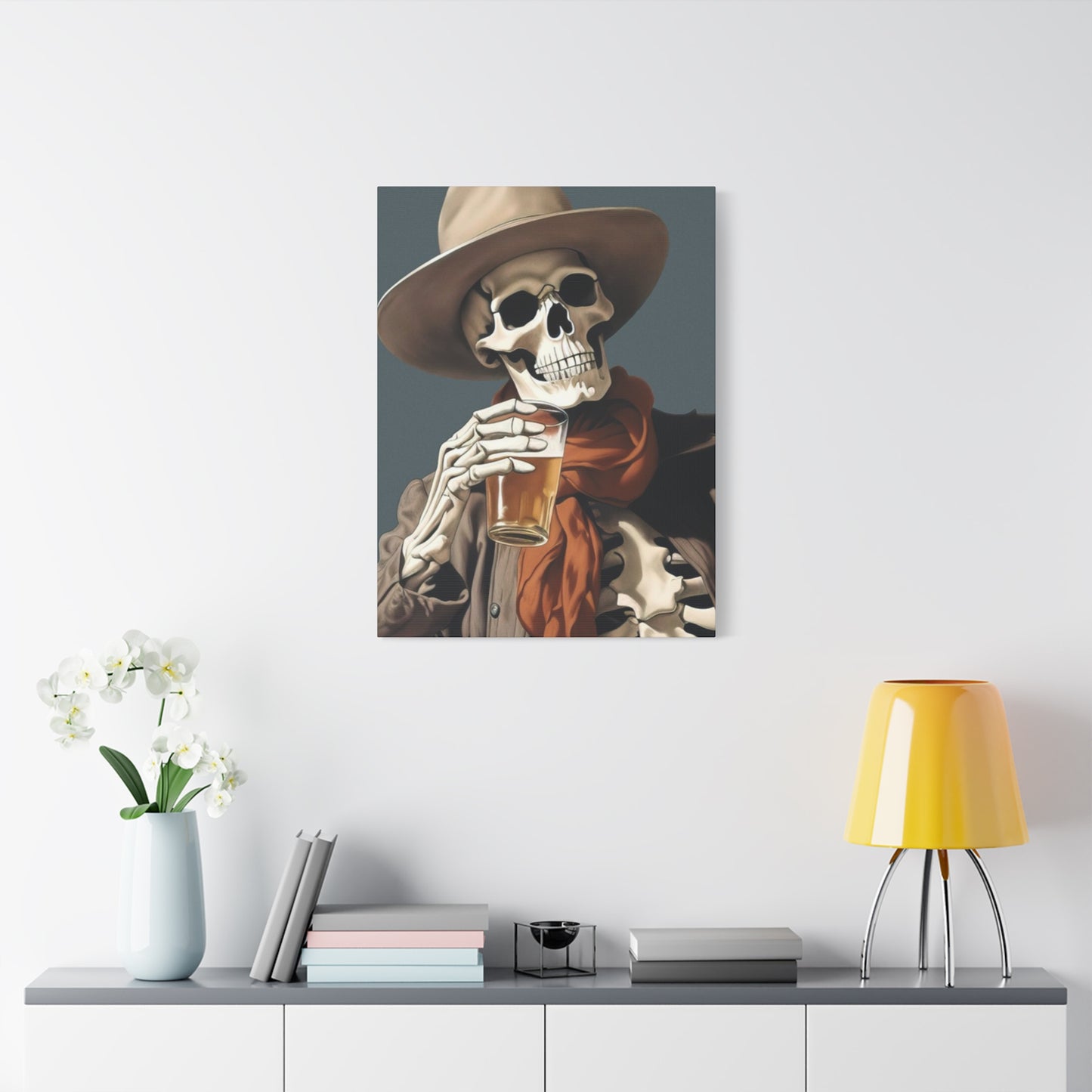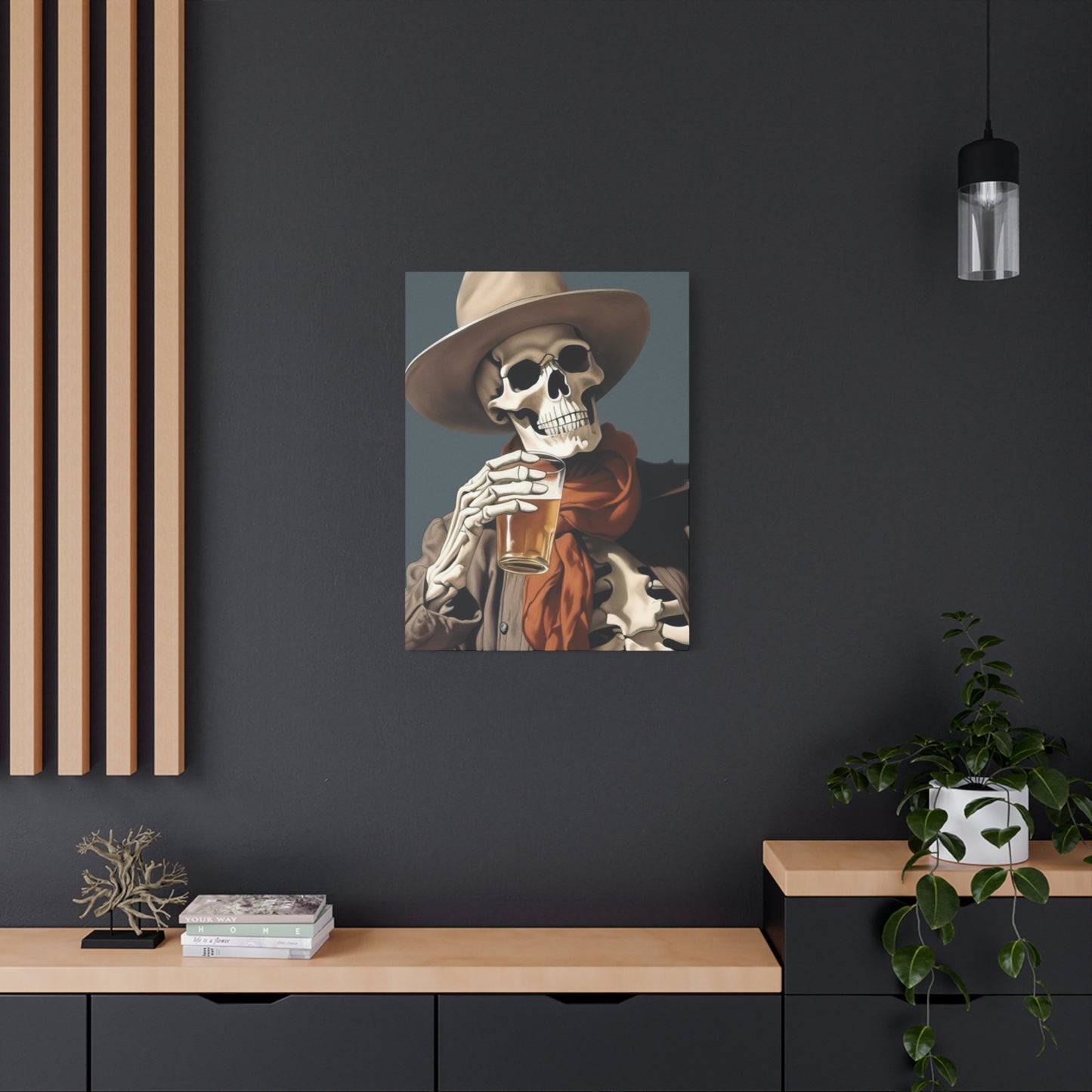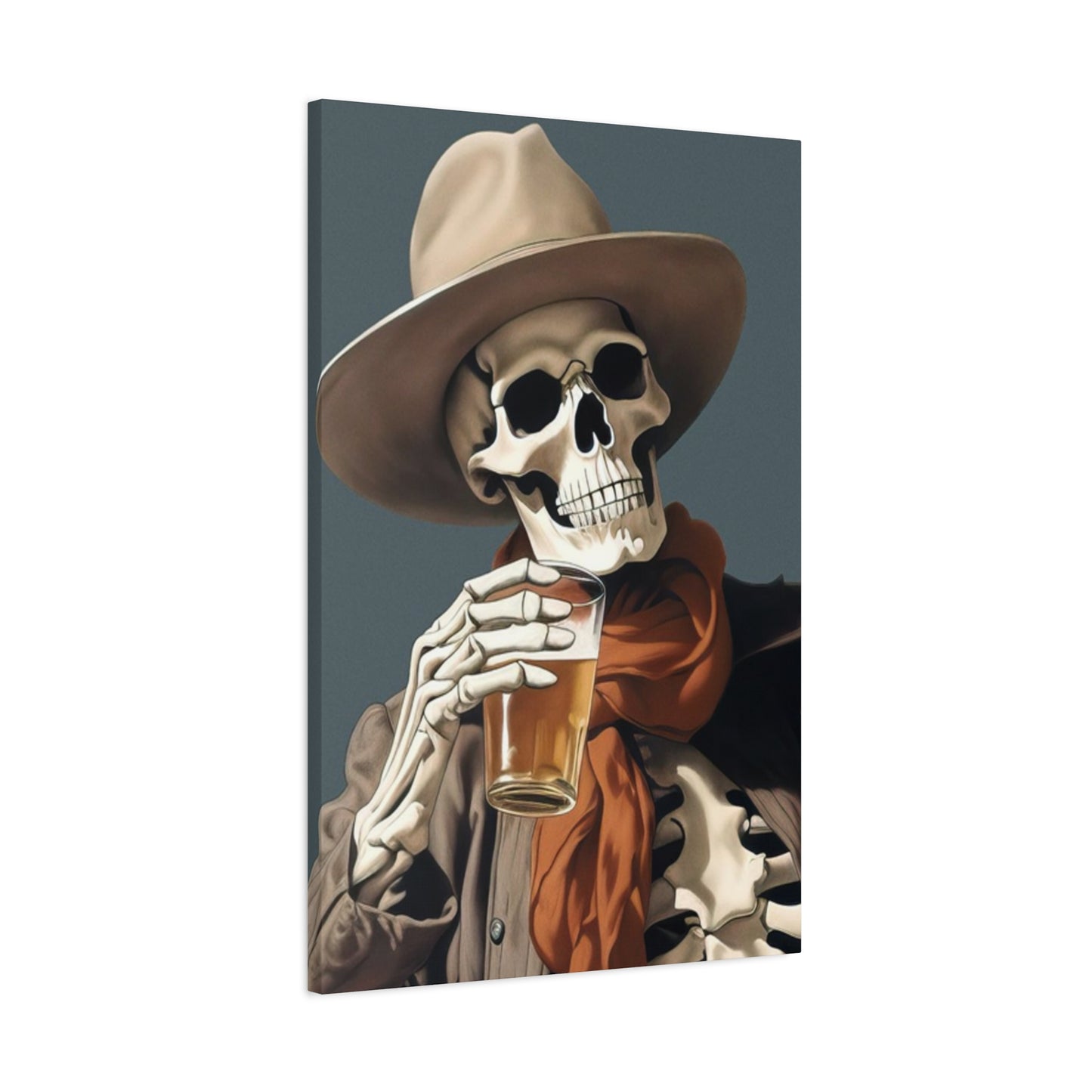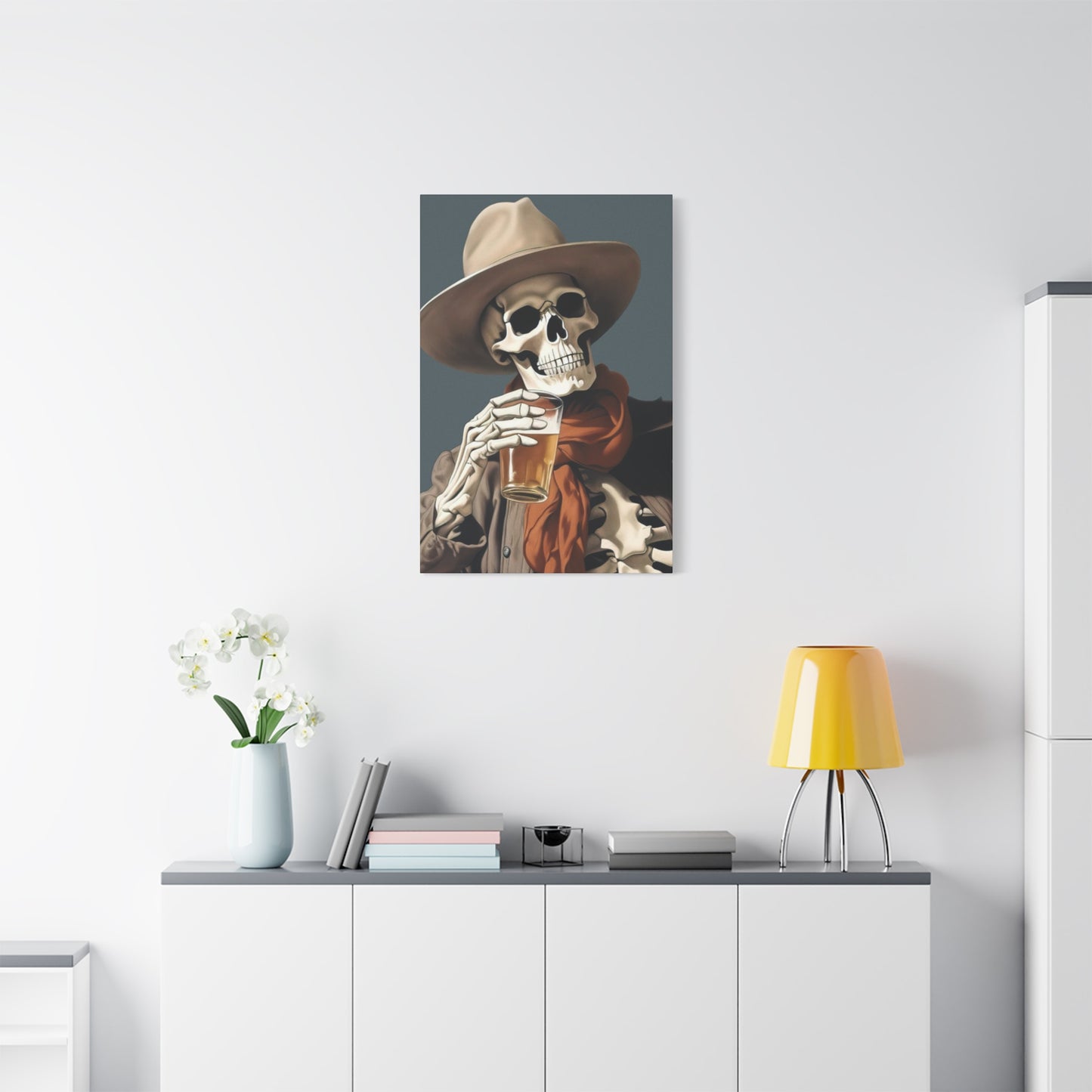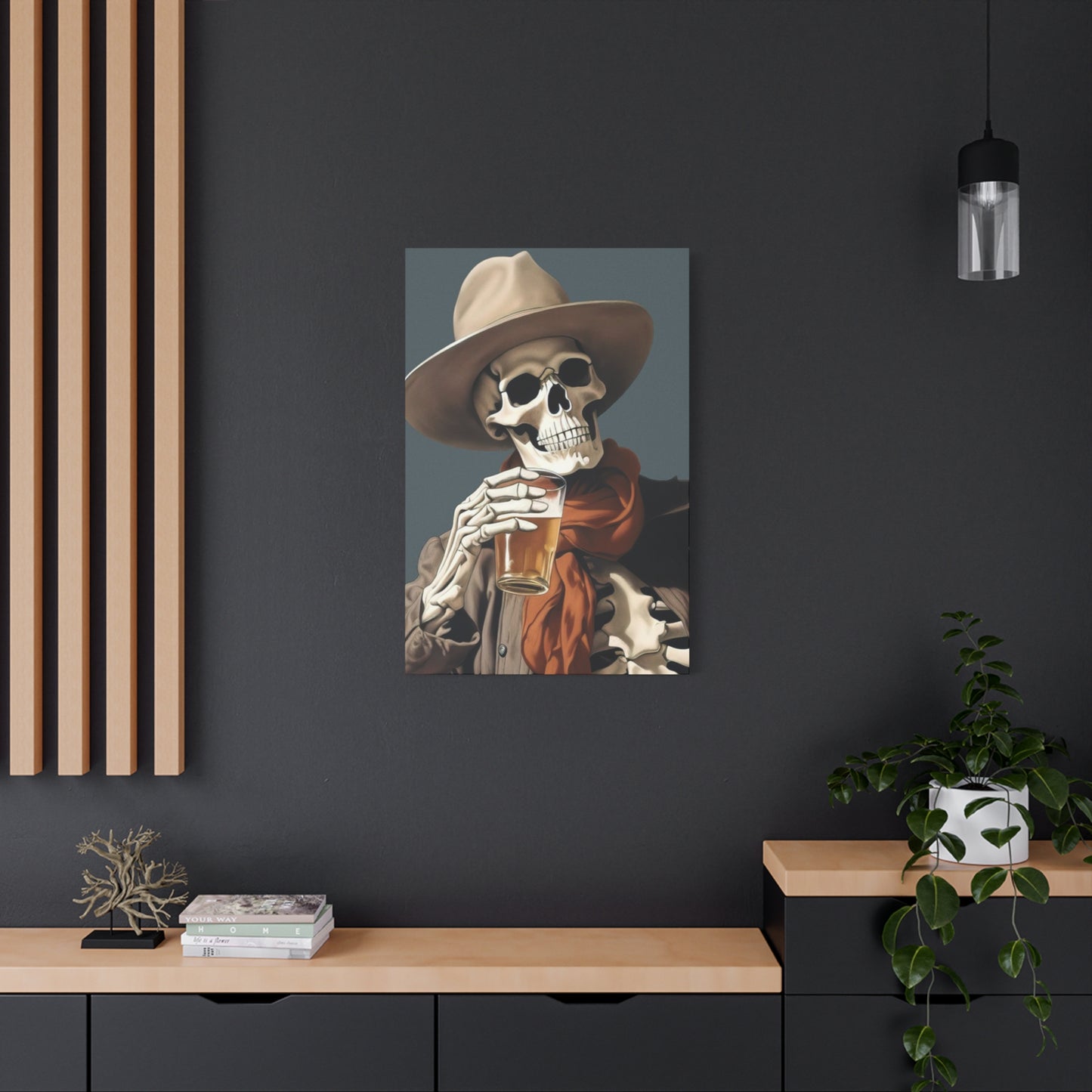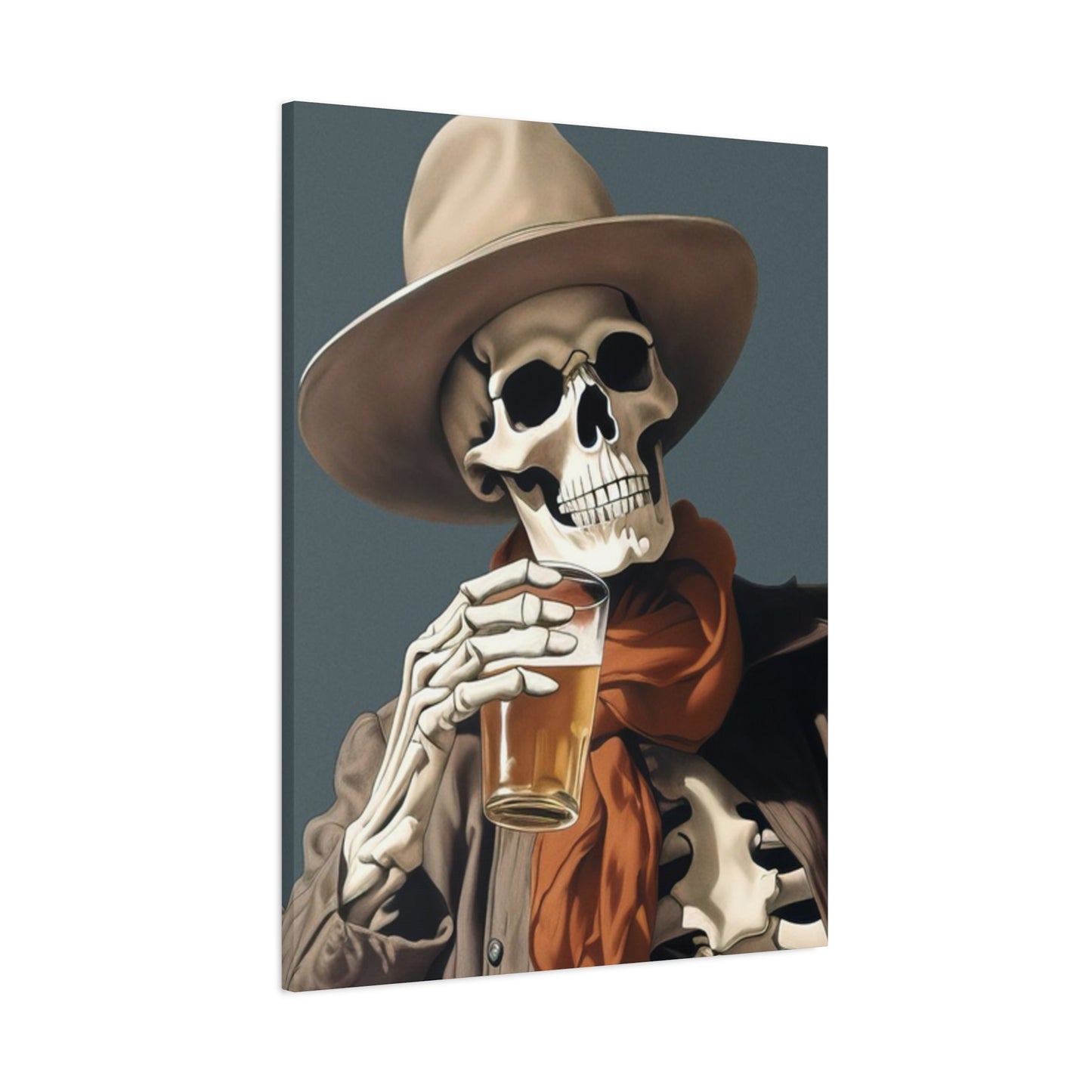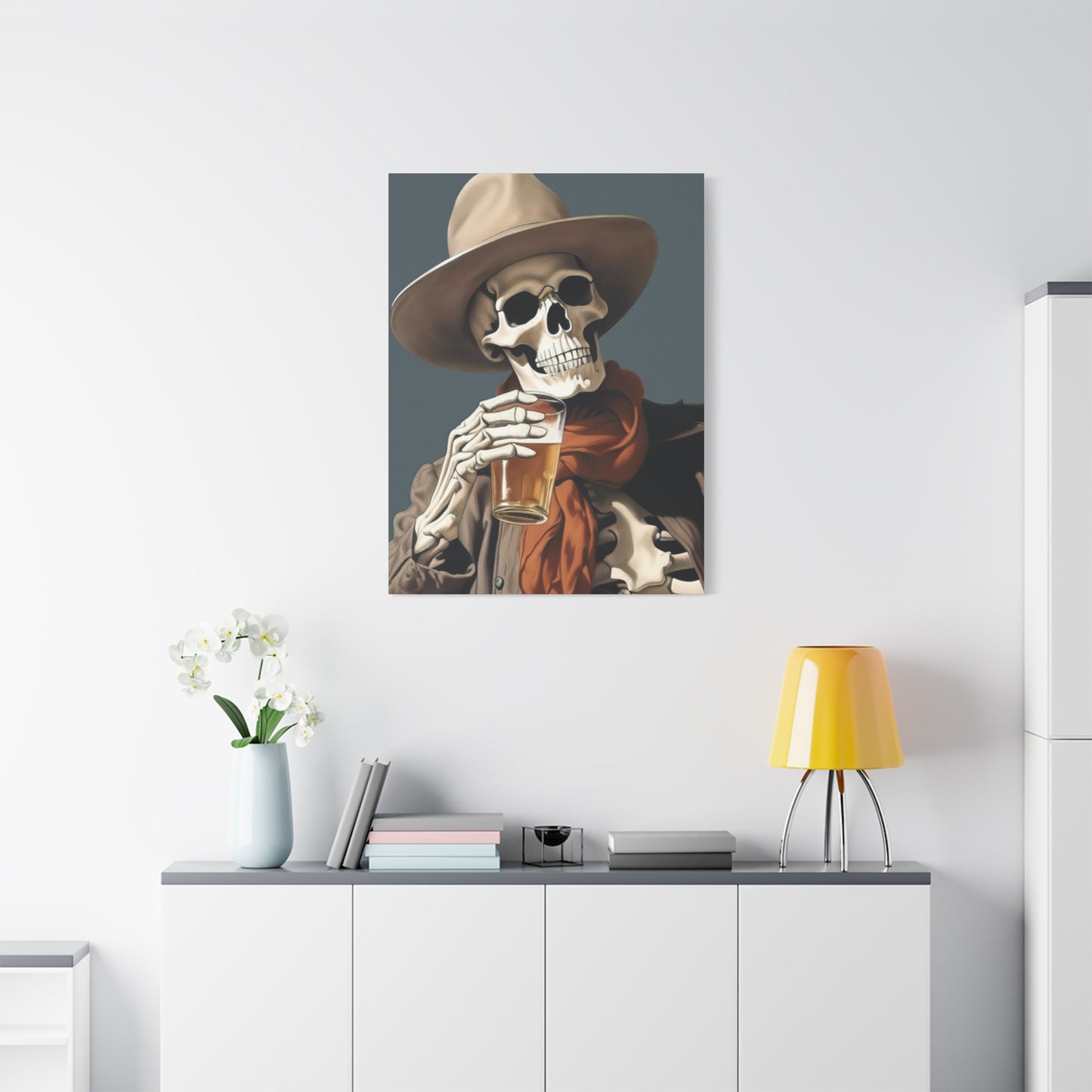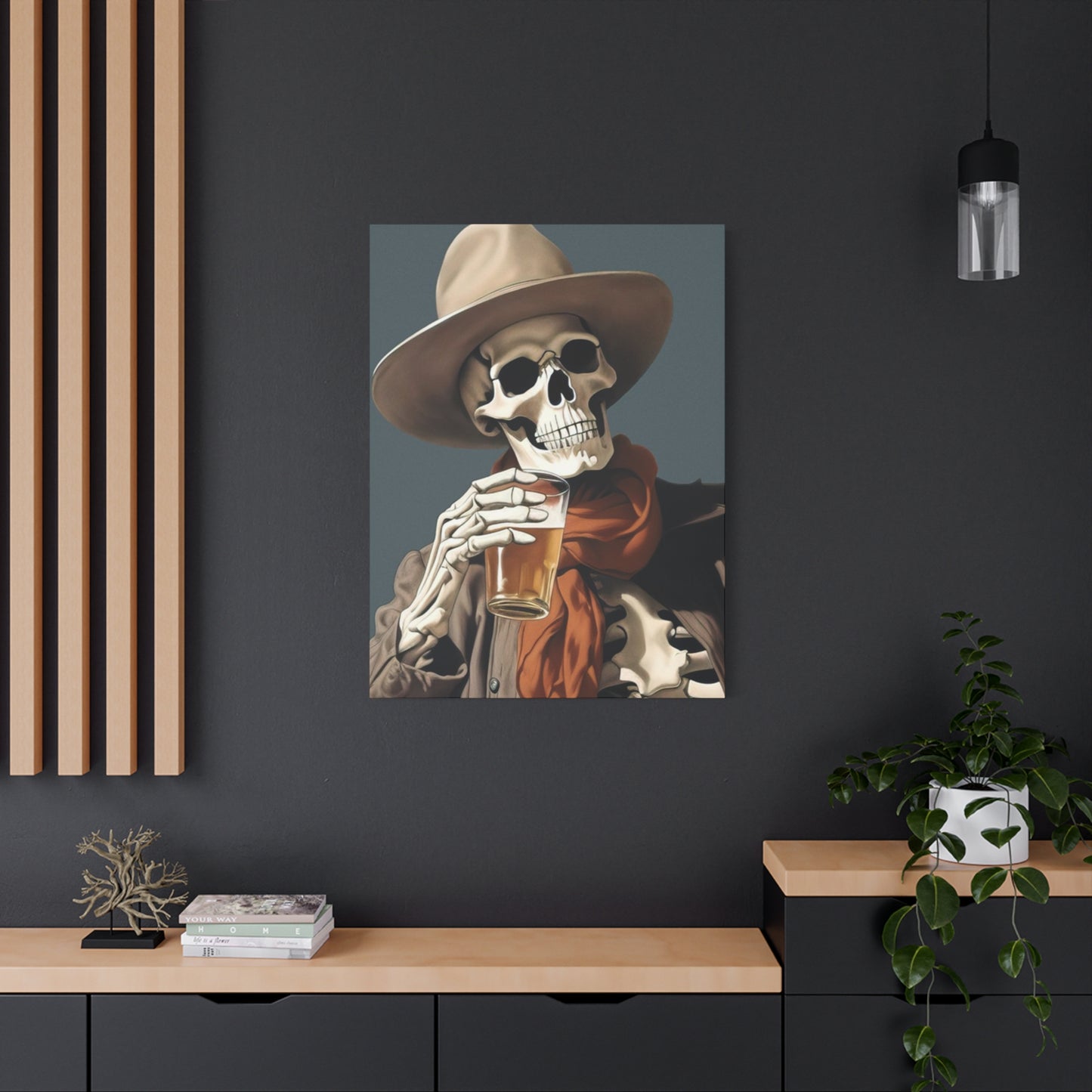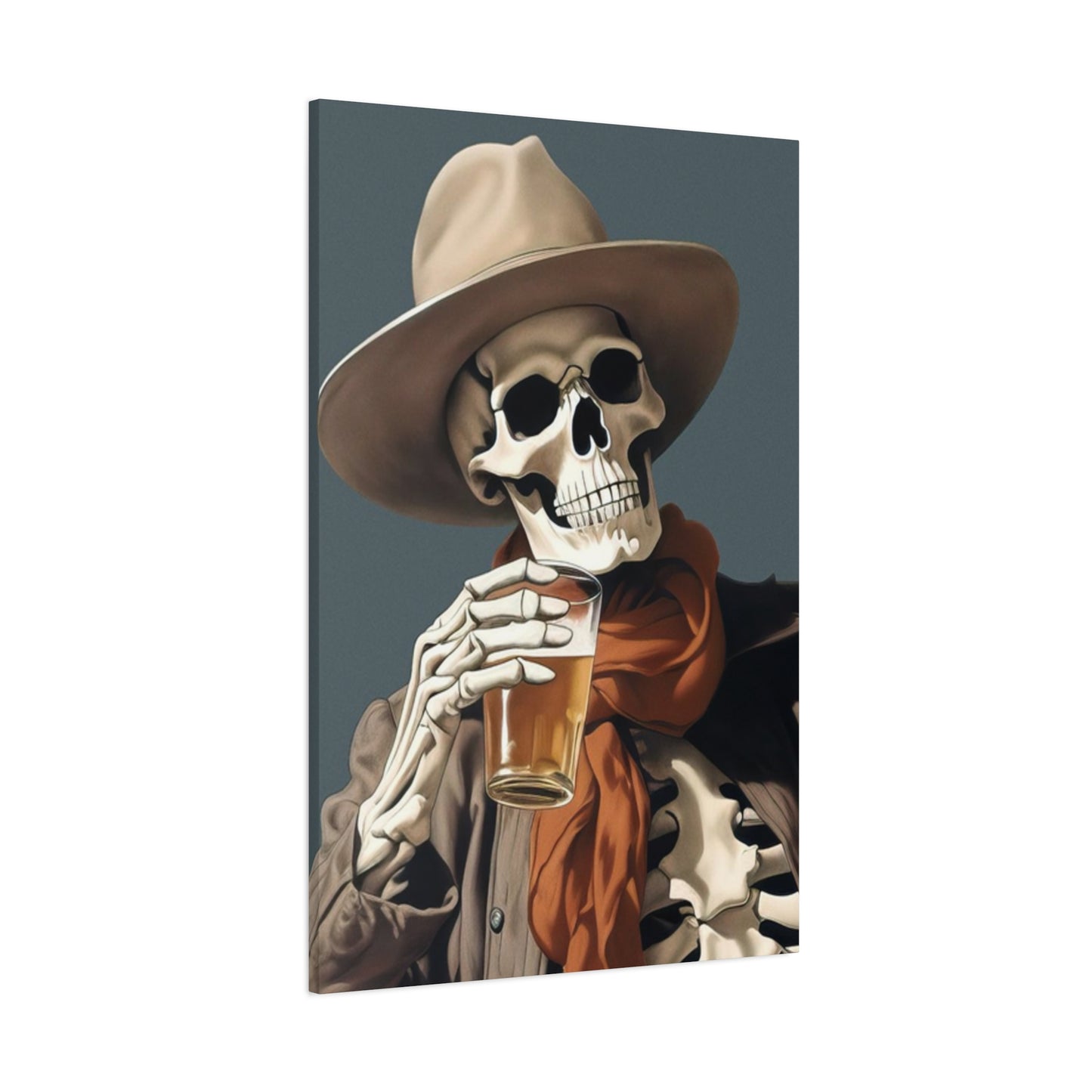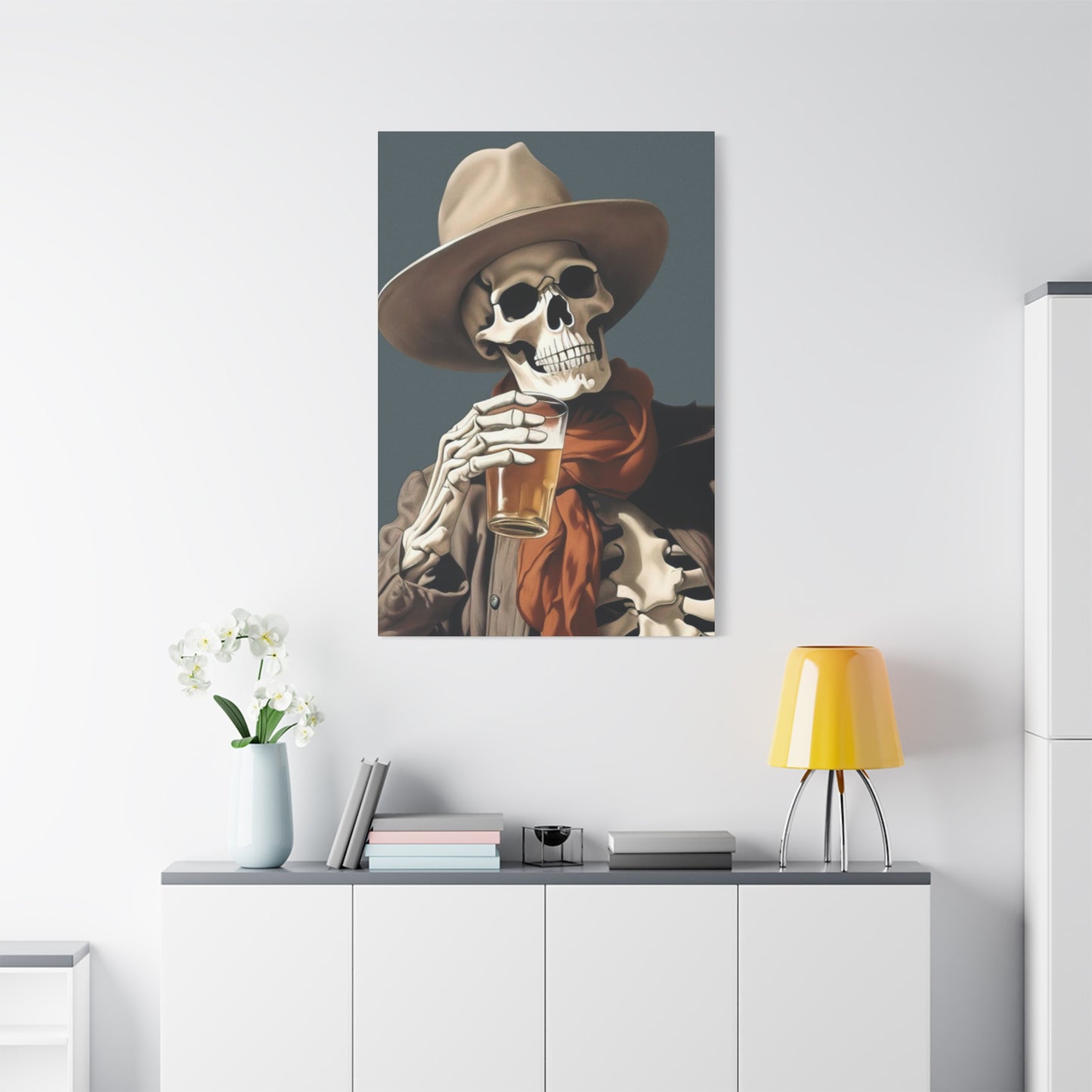Skeleton Cowboy Wall Art: Bold Artwork for Western and Gothic Enthusiasts
The fusion of Western frontier imagery with macabre skeletal themes has created one of the most compelling art movements in contemporary visual culture. Skeleton cowboy artwork represents a unique intersection where traditional American folklore meets gothic sensibility, producing pieces that captivate viewers with their mysterious charm and rebellious spirit. This distinctive art form has gained tremendous popularity among collectors, enthusiasts, and anyone seeking to add an element of dark Western mystique to their environment.
The appeal of skeleton cowboy imagery lies in its ability to tell stories without words, evoking tales of the Old West while incorporating elements of mortality, humor, and supernatural intrigue. These artworks serve as powerful conversation starters and create atmospheric focal points that transform ordinary rooms into extraordinary environments filled with character and personality.
From traditional paintings and illustrations to modern digital art and vintage-style posters, skeleton cowboy artwork encompasses a wide range of artistic expressions. The versatility of this theme allows artists to explore various techniques, color palettes, and compositional approaches while maintaining the core elements that make these pieces so visually striking and emotionally resonant.
Embracing the Dark Western Aesthetic Through Skeletal Cowboy Imagery
The dark Western aesthetic represents a fascinating evolution of traditional frontier art, incorporating elements of gothic horror, supernatural themes, and contemporary artistic sensibilities. Skeleton cowboy artwork embodies this aesthetic perfectly, combining the rugged individualism and lawless spirit of the Old West with the universal symbolism of mortality and the afterlife.
This artistic approach transforms familiar Western iconography into something more complex and layered. Traditional cowboy imagery such as wide-brimmed hats, bandanas, spurs, and six-shooters take on new meaning when associated with skeletal figures. The juxtaposition creates a sense of timelessness, suggesting that the spirit of the frontier continues beyond death, that the cowboy archetype transcends mortal boundaries.
The dark Western twist appeals to modern audiences who appreciate both nostalgia and contemporary edge. These artworks speak to viewers who are drawn to the romance of the frontier era while also embracing darker, more sophisticated themes. The skeleton cowboy becomes a symbol of rebellion against conventional Western imagery, offering a fresh perspective on well-worn themes.
Artists working in this genre often incorporate atmospheric elements such as stormy skies, abandoned saloons, ghostly landscapes, and supernatural lighting effects. These environmental details enhance the mysterious quality of the skeleton cowboy figure, creating compositions that feel both historically grounded and fantastically surreal. The result is artwork that captures the imagination and invites viewers to construct their own narratives around these enigmatic characters.
The popularity of this aesthetic extends beyond traditional art forms into fashion, tattoo culture, home decorating, and entertainment. Skeleton cowboy imagery has become synonymous with authentic American gothic style, representing a distinctly American take on dark romanticism that differs significantly from European gothic traditions.
Selecting Optimal Color Schemes for Drinking Skeleton Cowboy Paintings
Color selection plays a crucial role in the effectiveness of drinking skeleton cowboy paintings, as the right palette can enhance the mood, create visual impact, and ensure the artwork integrates seamlessly with its intended environment. Understanding color theory and psychological associations helps artists and collectors make informed decisions about which hues will best serve their artistic or decorative goals.
Traditional Western color palettes often feature warm earth tones such as burnt sienna, raw umber, ochre, and deep browns. These colors evoke the dusty landscapes of the frontier, weathered leather, and sun-baked adobe buildings. When applied to skeleton cowboy artwork, these warm tones create a sense of authenticity and historical connection while maintaining the rugged, masculine appeal associated with Western themes.
However, the skeletal element introduces opportunities for cooler color schemes that emphasize the supernatural aspects of the imagery. Deep blues, purples, and grays can create atmospheric effects that suggest moonlit nights, ghost towns, and otherworldly encounters. These cooler tones work particularly well when depicting drinking skeleton cowboys in saloon settings, as they can evoke the smoky, dimly lit atmosphere of frontier drinking establishments.
High contrast color schemes prove especially effective for skeleton cowboy artwork. The stark white or pale yellow of bone against dark backgrounds creates dramatic visual impact and ensures the skeletal figure remains the focal point of the composition. Black backgrounds allow artists to use selective lighting effects, highlighting specific elements such as the cowboy hat, whiskey bottle, or facial features of the skull.
Red accents serve multiple purposes in drinking skeleton cowboy paintings. Deep crimson can represent spilled whiskey, suggest danger or violence, or simply add visual warmth to otherwise cool compositions. Bright red elements such as bandanas, shirt details, or saloon lighting can create focal points and add energy to the overall design.
Metallic colors including gold, silver, and copper work exceptionally well for depicting various props associated with drinking skeleton cowboys. Golden whiskey, silver spurs, copper belt buckles, and metallic gun details add richness and authenticity to the artwork while creating subtle reflective qualities that catch the viewer's eye.
Incorporating Skeleton Cowboy Artwork in Music Venues and Bar Environments
Music venues and bar environments provide ideal settings for skeleton cowboy artwork, as these establishments often embrace edgy, unconventional decorative themes that appeal to patrons seeking authentic, memorable experiences. The rebellious spirit embodied by skeleton cowboy imagery aligns perfectly with the atmosphere of live music venues, craft breweries, and themed bars.
The scale of skeleton cowboy artwork becomes particularly important in commercial settings. Large-format pieces create dramatic focal points that can be seen clearly even in dimly lit environments typical of bars and music venues. Oversized skeleton cowboy paintings or prints can dominate entire walls, creating immersive environments that transport patrons into the world depicted in the artwork.
Serial installations of skeleton cowboy pieces work exceptionally well in longer venues such as hallways, stairwells, or extended bar areas. A series of related artworks can tell a visual story, following a skeleton cowboy character through various scenes and situations. This approach creates visual continuity while providing multiple points of interest for patrons to discover and discuss.
The positioning of skeleton cowboy artwork in bar environments requires careful consideration of lighting conditions and viewing angles. Pieces placed behind bars benefit from backlighting or accent lighting that creates dramatic shadows and highlights key elements of the composition. Artwork positioned near seating areas should be hung at appropriate heights for comfortable viewing by seated patrons.
Interactive elements can enhance the impact of skeleton cowboy artwork in music and bar settings. Some venues incorporate changeable elements such as different backgrounds, props, or lighting effects that transform the artwork throughout the evening. Digital displays can cycle through variations of skeleton cowboy imagery, keeping the visual environment fresh and engaging for regular patrons.
The durability of artwork becomes crucial in high-traffic commercial environments. Skeleton cowboy pieces intended for bars and music venues should be properly protected with appropriate framing, UV-resistant coatings, and secure mounting systems that can withstand the vibrations and activity typical of these establishments.
Choosing Appropriate Frames for Skeleton Cowboy Posters
Frame selection significantly impacts the visual effectiveness and longevity of skeleton cowboy posters, with the right frame enhancing the artwork while the wrong choice can diminish its impact or create visual discord with the intended environment. Understanding the relationship between frame style, material, and color helps ensure skeleton cowboy artwork achieves maximum visual impact.
Rustic wooden frames complement skeleton cowboy artwork exceptionally well, as the natural materials echo the frontier themes inherent in the imagery. Weathered barn wood, reclaimed lumber, and distressed finishes create authentic Western atmosphere while providing sturdy, attractive borders for the artwork. Dark walnut, mahogany, and ebony frames offer sophistication while maintaining the masculine appeal associated with cowboy themes.
Metal frames provide contemporary alternatives that work particularly well with skeleton cowboy artwork featuring modern artistic techniques or digital creation methods. Black steel, aged brass, and copper frames can echo metallic elements within the artwork itself, creating visual coherence between the frame and the image. Industrial-style frames with visible hardware or rivets enhance the edgy, rebellious character of skeleton cowboy imagery.
The width of the frame border affects the visual presence of skeleton cowboy posters significantly. Narrow frames allow maximum focus on the artwork itself, making them ideal for pieces with strong compositional elements or vibrant colors that command attention. Wide frames create more formal presentations and can help smaller posters achieve greater visual weight in larger environments.
Matting considerations become important when framing skeleton cowboy posters, particularly those created on standard paper stocks. Neutral mats in cream, gray, or black provide separation between the artwork and frame while preventing direct contact that could cause damage over time. Colored mats can either complement or contrast with the artwork, but should be chosen carefully to avoid overwhelming the visual impact of the skeleton cowboy imagery.
Glass selection affects both the appearance and preservation of skeleton cowboy posters. Standard glass provides basic protection while maintaining clear visibility, but can create unwanted reflections in certain lighting conditions. Anti-reflective glass eliminates glare issues but comes at higher cost. UV-filtering glass helps prevent fading and deterioration, making it particularly valuable for pieces displayed in areas with significant natural light exposure.
Skeleton Cowboys and Wild West Narratives Through Visual Storytelling
The visual storytelling potential of skeleton cowboy artwork allows artists and viewers to explore rich narratives that blend historical Western themes with supernatural elements, creating compelling stories that transcend the limitations of single images. These artworks invite viewers to imagine the circumstances that led to the skeletal cowboy's current state and to speculate about the adventures that might continue beyond death.
Traditional Wild West narratives often focus on themes of justice, revenge, survival, and redemption. Skeleton cowboy artwork can incorporate these same themes while adding layers of supernatural intrigue. A drinking skeleton cowboy might represent a gunfighter who met his end in a saloon shootout but continues to frequent his favorite establishment. This narrative framework allows viewers to construct elaborate backstories that enhance their emotional connection to the artwork.
The concept of the eternal cowboy resonates deeply with audiences who appreciate both Western mythology and supernatural themes. Skeleton cowboys suggest that the spirit of the frontier is so strong it persists beyond death, that certain individuals are so connected to the Western lifestyle they continue their adventures in the afterlife. This interpretation transforms skeleton cowboy artwork into symbols of dedication, authenticity, and unwavering commitment to personal values.
Environmental details within skeleton cowboy artwork contribute significantly to narrative development. Ghost towns, abandoned saloons, desolate landscapes, and supernatural atmospheric effects all provide context clues that help viewers understand the story being told. Artists can use these elements to suggest specific time periods, geographic locations, and circumstances surrounding their skeletal characters.
The inclusion of other characters, both living and dead, expands the narrative possibilities of skeleton cowboy artwork. Living characters might represent those who have not yet joined the skeletal cowboy in death, while other skeletal figures could suggest an entire community of supernatural frontier spirits. These multi-character compositions create opportunities for complex storytelling that engages viewers on multiple levels.
Sequential artwork series allow artists to develop skeleton cowboy narratives across multiple pieces, creating visual novels that can be displayed together or separately. These series might follow a single character through different adventures or explore the same themes from various perspectives, providing collectors with opportunities to build cohesive visual stories over time.
Establishing Atmospheric Moods Through Drinking Skeleton Cowboy Artwork
The atmospheric qualities of drinking skeleton cowboy artwork play crucial roles in determining the emotional impact and environmental integration of these pieces. Understanding how different artistic elements contribute to mood creation helps both artists and collectors achieve desired atmospheric effects that enhance the overall visual experience.
Lighting effects within drinking skeleton cowboy artwork dramatically influence the mood and atmosphere of the piece. Warm, golden lighting reminiscent of oil lamps or candlelight creates intimate, nostalgic atmospheres that suggest cozy saloon settings and friendly gatherings. Cool, blue lighting evokes mysterious, supernatural moods that emphasize the otherworldly nature of the skeleton cowboy character.
Dramatic chiaroscuro lighting techniques, which emphasize strong contrasts between light and dark areas, create theatrical atmospheres that heighten the visual impact of drinking skeleton cowboy compositions. These lighting effects can make the skeletal figure appear to emerge from shadows, creating surprise and intrigue that captures viewer attention and maintains interest.
Atmospheric perspective techniques help establish depth and environmental context within drinking skeleton cowboy artwork. Subtle color shifts, diminishing detail, and haze effects can suggest vast Western landscapes, smoky saloon interiors, or supernatural mists that enhance the mysterious character of the skeletal figure.
Weather elements such as storms, rain, snow, or dust add atmospheric drama to drinking skeleton cowboy compositions. These environmental factors can reflect the emotional state of the character, suggest danger or conflict, or simply create visual interest that enhances the overall composition.
The inclusion of architectural elements such as saloon doors, wooden bars, or frontier buildings helps establish specific atmospheric contexts that support the narrative elements of the artwork. These details provide viewers with familiar reference points that help them understand the setting and circumstances depicted in the piece.
Sound visualization techniques, though challenging to achieve in static artwork, can contribute to atmospheric development. Visual representations of music, laughter, or conversation through compositional elements such as flowing lines, rhythmic patterns, or suggestive gestures help viewers imagine the auditory environment surrounding the drinking skeleton cowboy.
Step-by-Step Approach to Drawing Drinking Skeleton Cowboys
Creating compelling drinking skeleton cowboy artwork requires understanding both anatomical structure and Western iconography, combined with artistic techniques that effectively communicate the supernatural and atmospheric qualities that make these images so engaging. A systematic approach helps artists develop skills progressively while ensuring all essential elements receive appropriate attention.
The initial sketch phase focuses on establishing basic proportions and pose dynamics for the skeleton cowboy figure. Beginning with simple geometric shapes helps artists work out the overall composition before committing to detailed anatomical elements. The drinking pose requires careful attention to arm positioning, hand placement, and the relationship between the figure and the drinking vessel.
Skeletal anatomy presents unique challenges and opportunities for artists working with drinking skeleton cowboy themes. Unlike flesh-covered figures, skeletal structures reveal underlying bone architecture that must be rendered accurately to maintain believability. However, artistic license allows for stylistic interpretations that emphasize character and mood over strict anatomical correctness.
Clothing and accessory details require careful observation of Western fashion and equipment. Cowboy hats, bandanas, vests, chaps, and boots all have specific structural characteristics that must be rendered convincingly. The way clothing interacts with the skeletal figure creates interesting visual contrasts and helps establish the character's personality and background.
Prop development, particularly the drinking vessel and its contents, adds crucial narrative and visual elements to the composition. Whether depicting whiskey bottles, beer mugs, or exotic cocktails, these elements require attention to reflection, transparency, and liquid behavior that enhances the realism and appeal of the artwork.
Environmental background elements provide context and atmosphere that support the main figure. Saloon settings, outdoor campfire scenes, or abstract atmospheric backgrounds all contribute to the overall narrative and emotional impact of the drinking skeleton cowboy artwork.
Final rendering techniques including shading, highlighting, and detail refinement bring the composition together into a cohesive, visually compelling artwork. Understanding how light interacts with bone surfaces, fabric textures, and reflective materials ensures the finished piece achieves maximum visual impact and emotional resonance.
Incorporating Skeleton Cowboy Themes in Halloween Decorating Schemes
Halloween provides perfect opportunities for incorporating skeleton cowboy artwork into seasonal decorating schemes that celebrate both traditional spooky themes and Western cultural elements. The natural connection between skeletal imagery and Halloween makes these artworks particularly effective during autumn celebrations while offering year-round appeal for enthusiasts of Western and gothic themes.
Temporary display options allow Halloween decorators to experiment with skeleton cowboy artwork without making permanent decorating commitments. Removable adhesive systems, temporary hanging solutions, and portable display stands enable creative positioning of skeleton cowboy pieces that can be adjusted or relocated as decorating schemes evolve throughout the Halloween season.
Lighting integration becomes particularly important during Halloween displays, as dramatic illumination effects can transform skeleton cowboy artwork into focal points that create memorable visual experiences. Colored lighting, strobing effects, and shadow projection techniques can animate static artworks and create dynamic, engaging displays that capture the attention of trick-or-treaters and party guests.
Layering skeleton cowboy artwork with traditional Halloween decorations creates unique fusion displays that stand out from conventional seasonal decorating approaches. Combining Western props such as lassos, horseshoes, and saloon doors with Halloween elements like cobwebs, pumpkins, and fog machines creates distinctive atmospheric environments that reflect both themes.
Interactive elements can enhance the Halloween appeal of skeleton cowboy displays. Motion-activated sound effects, animatronic components, or digital displays that respond to viewer presence create engaging experiences that entertain visitors while showcasing the skeleton cowboy artwork effectively.
Outdoor display considerations become important for Halloween decorating schemes that incorporate skeleton cowboy artwork. Weather protection, secure mounting systems, and appropriate lighting ensure that these displays remain attractive and safe throughout the Halloween season while protecting valuable artwork from environmental damage.
Scale relationships between skeleton cowboy artwork and other Halloween decorations require careful planning to achieve balanced, visually pleasing displays. Large skeleton cowboy pieces can serve as dramatic focal points, while smaller artworks can be grouped with complementary decorations to create cohesive themed areas within larger decorating schemes.
Balancing Humor and Horror Elements in Skeleton Cowboy Art
The most effective skeleton cowboy artwork successfully balances humorous and horrific elements, creating pieces that entertain while maintaining appropriate levels of spookiness that appeal to diverse audiences. This balance requires careful consideration of artistic choices that influence how viewers interpret and respond to the skeletal cowboy imagery.
Humorous elements in skeleton cowboy art often focus on the absurdity of skeletal figures engaging in everyday activities such as drinking, socializing, or playing cards. The contrast between the macabre appearance of the skeleton and the mundane nature of these activities creates comedic tension that makes viewers smile while appreciating the artistic creativity involved.
Anthropomorphic characteristics help make skeleton cowboy figures more relatable and less threatening to viewers who might otherwise be disturbed by skeletal imagery. Giving skeleton cowboys recognizable gestures, expressions, and body language helps viewers connect emotionally with these characters while maintaining the supernatural elements that make them visually interesting.
Horror elements in skeleton cowboy artwork typically focus on atmospheric details, supernatural implications, and the inherent mortality themes represented by skeletal figures. These elements add depth and sophistication to the artwork while appealing to viewers who appreciate darker, more complex emotional experiences.
The setting and context surrounding skeleton cowboy figures significantly influence the humor-horror balance within individual artworks. Lighthearted saloon scenes with multiple skeleton characters engaged in social activities tend toward the humorous end of the spectrum, while solitary figures in desolate landscapes emphasize more serious, contemplative themes.
Color choices and artistic techniques can shift the humor-horror balance within skeleton cowboy artwork. Bright, saturated colors and cartoonish rendering styles emphasize humorous elements, while muted palettes and realistic techniques create more serious, potentially frightening atmospheres.
Audience considerations help artists determine appropriate humor-horror balances for their skeleton cowboy artwork. Pieces intended for family environments might emphasize humorous elements while maintaining just enough spookiness to remain interesting, while artwork designed for adult audiences can explore darker themes and more sophisticated emotional territories.
Growing Popularity of Skeleton Cowboy Tattoos and Decorative Art
The rising popularity of skeleton cowboy imagery in tattoo culture reflects broader cultural trends toward authentic American symbolism, personalized artistic expression, and the celebration of rebellious, individualistic themes. This growing acceptance has influenced decorative art markets and created new opportunities for artists working with skeleton cowboy themes.
Tattoo-inspired artistic styles have influenced contemporary skeleton cowboy artwork, incorporating bold outlines, high contrast shading, and simplified color palettes that translate effectively across different artistic mediums. These stylistic approaches create visually striking pieces that maintain impact whether rendered as tattoos, paintings, or decorative prints.
The personal nature of tattoo art has encouraged more intimate, autobiographical approaches to skeleton cowboy imagery. Artists and collectors increasingly view these pieces as reflections of personal identity, life experiences, and individual aesthetic preferences rather than simply decorative elements.
Cultural authenticity concerns have elevated the importance of respectful, informed approaches to skeleton cowboy imagery that acknowledge Western American cultural heritage while avoiding stereotypical or offensive representations. This awareness has led to more sophisticated, nuanced artistic interpretations that celebrate rather than exploit Western themes.
Cross-media influences between tattoo culture and decorative art have created new hybrid artistic approaches that combine traditional tattoo techniques with contemporary art methods. These innovations have expanded the visual vocabulary available to artists working with skeleton cowboy themes and created new aesthetic possibilities.
The collectible nature of skeleton cowboy artwork has increased as tattoo culture has mainstream acceptance and cultural credibility. Collectors increasingly seek original artwork by tattoo artists and pieces that reflect the authentic aesthetic qualities associated with this artistic tradition.
Commercial applications of skeleton cowboy imagery have expanded beyond traditional art markets into fashion, merchandise, and lifestyle products that appeal to consumers who appreciate the rebellious, authentic character of these themes. This commercial success has created new opportunities for artists while increasing the visibility and cultural impact of skeleton cowboy artwork.
Combining Skeleton Cowboy Art with Rustic and Vintage Decorating Themes
The integration of skeleton cowboy artwork with rustic and vintage decorating schemes creates harmonious environments that celebrate American cultural heritage while incorporating contemporary artistic sensibilities. Understanding how these elements work together helps decorators achieve cohesive, authentic results that enhance both the artwork and the overall decorating theme.
Rustic decorating elements such as reclaimed wood, vintage leather, aged metals, and natural stone provide perfect contextual frameworks for skeleton cowboy artwork. These materials echo the frontier heritage represented by the cowboy imagery while creating authentic atmospheric backgrounds that enhance the visual impact of skeletal themes.
Vintage Western memorabilia including old saddles, spurs, horseshoes, and frontier tools can be displayed alongside skeleton cowboy artwork to create comprehensive themed environments. These authentic artifacts provide historical context while complementing the supernatural elements represented by the skeletal figures.
Color coordination between skeleton cowboy artwork and rustic decorating elements requires attention to natural earth tones, weathered finishes, and authentic material colors. The warm browns, deep reds, and muted golds typical of rustic decorating schemes work exceptionally well with traditional skeleton cowboy artwork palettes.
Textural variety becomes important when combining skeleton cowboy art with rustic decorating themes. Smooth artwork surfaces contrast effectively with rough wood textures, smooth leather patinas, and irregular stone surfaces, creating visual interest that enhances the overall decorating scheme.
Scale relationships between skeleton cowboy artwork and rustic decorating elements require careful planning to achieve balanced compositions. Large rustic furniture pieces can support substantial skeleton cowboy artworks, while smaller rustic accessories work well with more modest artistic pieces.
Lighting considerations become particularly important in rustic environments, as the warm, intimate lighting typical of these decorating schemes can enhance the atmospheric qualities of skeleton cowboy artwork while creating comfortable, inviting environments for viewing and appreciation.
Appealing to Biker Culture and Western Enthusiasts Through Skeleton Cowboy Art
Skeleton cowboy artwork resonates strongly with both biker culture and Western enthusiasts, as these communities appreciate themes of rebellion, independence, mortality awareness, and authentic American cultural expression. Understanding the specific aesthetic preferences and cultural values of these audiences helps artists create pieces that speak directly to their interests and sensibilities.
Biker culture embraces imagery that celebrates freedom, danger, and the rejection of conventional social expectations. Skeleton cowboy artwork embodies these values through its combination of mortality symbolism and frontier independence, creating pieces that align perfectly with biker aesthetic preferences and philosophical outlooks.
The mechanical elements associated with motorcycle culture can be incorporated into skeleton cowboy artwork to create fusion pieces that appeal specifically to biker audiences. Skeletal cowboys depicted with motorcycles, mechanical accessories, or industrial backgrounds create unique artistic statements that celebrate both Western and biker traditions.
Western enthusiasts appreciate authentic historical references, accurate period details, and respectful treatment of cowboy culture and heritage. Skeleton cowboy artwork that demonstrates understanding of Western history, equipment, and lifestyle appeals to these audiences while offering fresh perspectives on familiar themes.
The rebellious spirit shared by both biker and Western cultures creates common ground for skeleton cowboy artwork that emphasizes themes of individualism, resistance to authority, and celebration of dangerous, adventurous lifestyles. These themes resonate across both communities and create broad appeal for well-executed skeleton cowboy pieces.
Quality expectations within both biker and Western enthusiast communities tend to be high, with appreciation for authentic materials, skilled craftsmanship, and attention to cultural details. Skeleton cowboy artwork intended for these audiences should demonstrate respect for both artistic and cultural traditions while offering contemporary relevance and visual impact.
Customization opportunities appeal to both biker and Western communities, as members of these groups often seek personalized artistic expressions that reflect individual experiences, preferences, and identities. Custom skeleton cowboy artwork can incorporate specific details, locations, or personal elements that create unique, meaningful pieces for individual collectors.
Creating Dynamic Visual Effects with Neon Lighting and Skeleton Cowboy Posters
The combination of neon lighting effects with skeleton cowboy posters creates striking visual displays that capture attention and create memorable atmospheric experiences. Understanding how different lighting colors, intensities, and placement options interact with skeleton cowboy imagery helps create effective installations that maximize visual impact while maintaining artistic integrity.
Neon color selection significantly influences the mood and character of skeleton cowboy poster displays. Traditional neon colors such as electric blue, hot pink, and bright green create contemporary, edgy atmospheres that emphasize the rebellious aspects of skeleton cowboy imagery. Warmer neon tones including orange, red, and yellow create more traditional Western atmospheres while maintaining the dynamic energy associated with neon lighting.
Backlighting techniques using neon create dramatic silhouette effects that can transform skeleton cowboy posters into glowing focal points. Positioning neon elements behind translucent or semi-transparent poster materials creates even illumination that highlights the artwork while creating striking visual contrast against darker environments.
Accent lighting approaches use neon elements to highlight specific details within skeleton cowboy posters rather than illuminating the entire piece. Selective neon highlighting can emphasize key elements such as the skeleton figure, drinking vessels, or environmental details while leaving other areas in relative darkness for dramatic effect.
Color cycling and dynamic lighting effects create animated displays that bring static skeleton cowboy posters to life through changing illumination patterns. Programmable neon systems can create sequences that shift colors, intensity, or patterns to maintain visual interest and create unique viewing experiences throughout different time periods.
Installation considerations for neon lighting systems include electrical requirements, heat management, safety protocols, and maintenance accessibility. Properly planned installations ensure that neon elements enhance skeleton cowboy artwork without creating hazards or requiring excessive ongoing maintenance.
The interaction between neon lighting and different poster materials affects the final visual result significantly. Glossy poster surfaces create reflective effects that can amplify neon illumination, while matte finishes provide more subdued, even light distribution. Understanding these material properties helps achieve desired lighting effects.
Gothic Charm and Drinking Skeleton Cowboy Illustrations
The gothic charm inherent in drinking skeleton cowboy illustrations stems from their ability to combine romantic darkness with frontier authenticity, creating artworks that appeal to viewers who appreciate both macabre beauty and Western cultural themes. This unique aesthetic attracts collectors and enthusiasts seeking distinctive decorative elements that reflect sophisticated artistic tastes.
Gothic aesthetic elements including dramatic lighting, romantic darkness, supernatural themes, and emotional intensity find natural expression within skeleton cowboy imagery. The combination of mortality symbolism with cowboy iconography creates compelling visual narratives that explore themes of eternal love, tragic loss, and transcendent adventure.
Romantic interpretations of skeleton cowboy imagery often focus on themes of eternal devotion, undying loyalty, and love that persists beyond death. Drinking skeleton cowboys can represent lovers who continue to toast their relationships in the afterlife, creating touching narratives that appeal to viewers who appreciate romantic gothic themes.
The melancholic beauty associated with gothic aesthetics translates effectively into skeleton cowboy illustrations through careful attention to atmospheric details, emotional expression, and symbolic elements. These artistic choices create pieces that evoke contemplation and emotional response while maintaining the visual appeal necessary for successful decorative art.
Victorian gothic influences can be incorporated into skeleton cowboy illustrations through period costume details, architectural elements, and decorative motifs that bridge the gap between frontier themes and European gothic traditions. These fusion approaches create unique artistic statements that appeal to collectors interested in both American and European cultural themes.
Contemporary gothic interpretations of skeleton cowboy imagery often incorporate modern artistic techniques, digital art methods, and current aesthetic trends while maintaining the core emotional and symbolic elements that define gothic charm. These approaches create artworks that feel both timeless and contemporary.
The collectible appeal of gothic skeleton cowboy illustrations has increased as gothic aesthetic appreciation has gained mainstream acceptance. Collectors seek pieces that demonstrate artistic skill, cultural awareness, and emotional depth while providing distinctive decorative elements that reflect personal aesthetic preferences.
Creating Skeleton Cowboy Art for Home Production and Personal Projects
The accessibility of modern artistic tools and techniques has made it possible for enthusiasts to create their own skeleton cowboy artwork for personal enjoyment, home decoration, and gift-giving purposes. Understanding the available options and approaches helps individuals develop skills and create meaningful pieces that reflect personal aesthetic preferences and cultural interests.
Digital art creation tools including drawing tablets, illustration software, and online resources provide accessible entry points for individuals interested in creating skeleton cowboy artwork. These tools offer extensive creative possibilities while allowing for easy experimentation, correction, and reproduction of successful pieces.
Traditional art techniques including drawing, painting, and printmaking continue to offer valuable approaches for creating skeleton cowboy artwork. Understanding basic artistic principles, material properties, and technique applications helps individuals create authentic, personally meaningful pieces using conventional artistic methods.
Reference material collection helps ensure accuracy and authenticity in personally created skeleton cowboy artwork. Gathering images of Western equipment, skeletal anatomy, period clothing, and environmental details provides essential information for creating convincing, respectful artistic interpretations.
Skill development through practice, experimentation, and study gradually improves the quality and sophistication of personally created skeleton cowboy artwork. Regular practice sessions, technique exploration, and artistic study help individuals develop capabilities that produce increasingly satisfying results.
Project planning including conceptual development, composition design, and technical preparation helps ensure successful outcomes for skeleton cowboy art projects. Careful planning prevents common problems while maximizing the likelihood of creating pieces that meet personal artistic goals and aesthetic expectations.
Sharing and display considerations help individuals present their skeleton cowboy artwork effectively while protecting the pieces from damage and deterioration. Understanding framing, mounting, and display options ensures that personally created artworks achieve maximum visual impact and longevity.
Skeleton Cowboys in Popular Culture and Contemporary Art Movements
The presence of skeleton cowboy imagery in popular culture reflects broader cultural trends toward authenticity, rebellion, and the celebration of American cultural heritage through contemporary artistic lenses. Understanding these cultural connections helps appreciate the significance and appeal of skeleton cowboy artwork within larger artistic and social contexts.
Entertainment industry applications of skeleton cowboy imagery span movies, television, video games, and music, creating widespread cultural exposure that increases public familiarity and appreciation for these themes. Popular culture representations influence artistic interpretation and create market demand for related decorative artwork.
Music culture connections between skeleton cowboy imagery and various musical genres including country, rock, punk, and alternative music create natural synergies that support artistic development and commercial success. Musicians and music fans often appreciate skeleton cowboy artwork as expressions of shared aesthetic values and cultural interests.
Fashion industry adoption of skeleton cowboy themes has created mainstream awareness and appreciation for these aesthetic elements. Clothing, accessories, and lifestyle products featuring skeleton cowboy imagery introduce these themes to broader audiences while creating commercial opportunities for artists working in this area.
Contemporary art movement integration has elevated skeleton cowboy imagery beyond simple decoration into serious artistic territory that engages with important cultural themes and artistic traditions. Gallery exhibitions, museum collections, and critical discourse have established credibility and cultural significance for high-quality skeleton cowboy artwork.
Social media influence has dramatically increased the visibility and cultural impact of skeleton cowboy artwork through platforms that enable artists to share their work with global audiences. Online communities, viral sharing, and digital marketing have created new opportunities for artistic exposure and commercial success.
Cultural authenticity discussions surrounding skeleton cowboy imagery have encouraged more thoughtful, respectful approaches to Western themes that acknowledge historical complexity while celebrating positive cultural values. These conversations have improved artistic quality while increasing cultural credibility and acceptance.
Bold Statement Pieces Featuring Skeleton Cowboys with Whiskey Elements
Skeleton cowboys depicted with whiskey bottles, glasses, and drinking themes create particularly bold artistic statements that combine mortality symbolism with celebratory imagery, resulting in pieces that provoke thought while maintaining visual appeal and decorative effectiveness. These artworks work exceptionally well as focal points in environments that appreciate edgy, conversation-starting decorative elements.
Whiskey symbolism within skeleton cowboy artwork carries multiple meanings including celebration, defiance, camaraderie, and the dulling of mortal concerns. The juxtaposition of alcoholic celebration with skeletal mortality creates complex emotional narratives that engage viewers on intellectual and emotional levels while providing visually striking decorative elements.
Compositional approaches for skeleton cowboys with whiskey elements range from intimate portrait-style depictions to elaborate scene compositions featuring multiple characters and environmental details. Each approach offers different opportunities for artistic expression and narrative development while maintaining the central theme of skeletal figures engaged with alcoholic beverages.
Bottle and glass rendering presents specific technical challenges and opportunities for artists working with skeleton cowboy and whiskey themes. Accurate depiction of glass transparency, liquid behavior, and reflective surfaces requires understanding of these materials while offering chances to demonstrate artistic skill and create visually compelling focal points.
Brand incorporation allows artists to reference specific whiskey brands and products within their skeleton cowboy artwork, creating additional layers of meaning and cultural reference. However, this approach requires careful consideration of copyright, trademark, and commercial use issues that may affect how such artworks can be displayed and sold.
Scale considerations become important when creating bold statement pieces featuring skeleton cowboys with whiskey elements. Large-format artworks create dramatic visual impact suitable for prominent display locations, while smaller intimate pieces work well in personal environments where closer viewing allows appreciation of detailed artistic elements.
Environmental context within skeleton cowboy and whiskey artwork helps establish setting, mood, and narrative framework. Saloon environments, outdoor campfire scenes, and abstract atmospheric backgrounds all provide different contextual frameworks that support the central imagery while contributing to overall artistic effectiveness.
Using Skeleton Cowboy Art as Conversation Starters and Social Focal Points
The inherently provocative nature of skeleton cowboy artwork makes these pieces exceptionally effective as conversation starters and social focal points that encourage interaction, discussion, and shared appreciation among viewers. Understanding how to position and present these artworks maximizes their social effectiveness while ensuring they contribute positively to environmental atmosphere.
Strategic placement of skeleton cowboy artwork in high-traffic areas ensures maximum exposure and social interaction potential. Entry areas, main living rooms, and central hallways provide opportunities for guests and visitors to encounter these pieces naturally while moving through environments, creating organic opportunities for artistic discussion and appreciation.
Grouping multiple skeleton cowboy pieces creates comprehensive displays that offer extended viewing and discussion opportunities. Series installations, thematic collections, and varied artistic approaches within single display areas provide multiple conversation topics while demonstrating broader appreciation for skeleton cowboy artistic themes.
Interactive elements accompanying skeleton cowboy artwork can enhance social engagement and encourage viewer participation. Information cards, artist statements, or historical context materials help viewers understand and appreciate the cultural and artistic significance of skeleton cowboy imagery while providing conversation topics and educational opportunities.
Lighting design affects the social impact of skeleton cowboy artwork by influencing viewing comfort, atmospheric mood, and visual accessibility. Proper illumination ensures that artwork details remain visible and engaging while creating comfortable environments for social interaction and artistic discussion.
Cultural context explanation helps viewers understand and appreciate the significance of skeleton cowboy imagery within American artistic and cultural traditions. Providing background information about Western heritage, gothic aesthetic influences, and contemporary artistic movements helps viewers develop informed opinions and engage in meaningful discussions about these artworks.
Personal connection encouragement helps transform skeleton cowboy artwork from mere decoration into meaningful focal points that reflect individual taste, cultural appreciation, and artistic sensitivity. Encouraging viewers to share personal responses, cultural connections, and aesthetic preferences creates more engaging social experiences around these artistic pieces.
Optimizing Skeleton Cowboy Posters for Man Cave and Game Room Environments
Man cave and game room environments provide ideal settings for skeleton cowboy posters, as these masculine-oriented environments typically embrace bold, unconventional decorative themes that reflect personal interests and create distinctive atmospheric experiences. Understanding the specific requirements and opportunities of these environments helps ensure skeleton cowboy artwork achieves maximum impact and integration.
Scale proportions become crucial in man cave and game room environments, which often feature larger furniture pieces and more substantial architectural elements than typical residential rooms.
Conclusion
Skeleton cowboy wall art is a striking fusion of Western grit and Gothic edge, creating bold visuals that captivate enthusiasts of both styles. This genre blends the rugged spirit of the American West with dark, mysterious motifs, symbolized by the skeletal figure of the cowboy—a powerful image that evokes themes of mortality, resilience, and timeless adventure. Whether you're drawn to Western heritage or Gothic aesthetics, skeleton cowboy art offers a unique and evocative way to express your passion through your décor.
The artwork’s raw energy comes from its daring contrast between life and death, tradition and rebellion. Detailed depictions of skeletal cowboys riding through barren landscapes, framed by classic Western iconography like hats, boots, and revolvers, tell stories steeped in myth and legend. This fusion invites viewers to explore complex narratives of survival, honor, and the supernatural, making it a compelling focal point for any room.
From a design perspective, skeleton cowboy wall art complements industrial, rustic, and eclectic interiors, adding depth and intrigue. Its bold lines, dramatic shading, and often monochromatic or muted color palettes make it versatile for various settings, from man caves and game rooms to contemporary living spaces. Pairing this artwork with vintage Western décor or Gothic accents like wrought iron and distressed leather can further enhance the thematic impact.
Beyond aesthetics, skeleton cowboy art resonates on a symbolic level, reminding us of life’s fleeting nature and the enduring spirit of the frontier. It challenges traditional Western imagery by adding a darker, more contemplative dimension, appealing to those who appreciate art with both edge and narrative.
In conclusion, skeleton cowboy wall art stands out as a powerful artistic statement that bridges Western heritage with Gothic allure. It enriches your space with bold storytelling, symbolic depth, and a striking visual presence. Whether you’re a Western aficionado or a Gothic art lover, this genre offers an exciting way to celebrate your unique style and create a dynamic, conversation-starting environment.

















